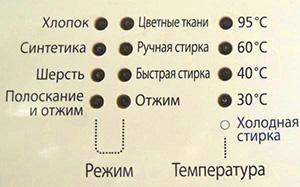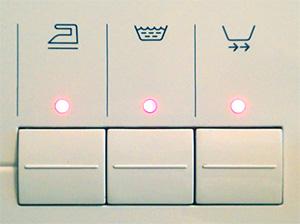Washing machines in our time are literally "stuffed" with various functions that help them cope with different types of dirt on different types of laundry, and we get clean clothes, without much effort. Washing modes in washing machines are the tool that allows us to “explain” to the washing machine what result we want to get and how it needs to wash clothes for this. Manufacturers have provided washing modes for any type of laundry and we need to use them correctly so that things do not deteriorate and serve us for a long time. Therefore, let's look at the values \u200b\u200bof the modes on the washing machine.
Standard wash cycles

The following washing modes are present in almost every washing machine. They may differ slightly in name, but the essence remains the same.
- Cotton - this is probably the most common washing mode that is present in every automatic washing machine. He assumes washing bed linen or heavily soiled cotton clothing at 95°C. Washing is usually not fast, and the spin cycle uses the maximum number of revolutions available to the washing machine.
- Synthetics - the second most popular washing program, which involves washing synthetic fabrics in a washing machine at a temperature not exceeding 60 ° C.Also, as with the "cotton" program, washing takes a long time and the maximum number of revolutions is used.
- Hand wash mode - is also a very common feature in the washing machine, which allows you to wash delicate fabrics very gently. For example, using this mode, well wash tulle in washing machine. Usually washing in this mode occurs at a temperature of 30 - 40 ° C.The drum rotates slowly and very carefully. There is no pressing.
- Delicate wash - as well as hand washing, it is intended for washing delicate fabrics, but, on different models, it may have a spin cycle. More about delicate washing you can read separately.
- Quick wash in the washing machine - designed for lightly soiled clothes and is suitable for refreshing a wardrobe item. Washing takes place very quickly, usually no more than 30 minutes, at low temperatures. The maximum spin speed is used. Also it can be called "Express", "Daily wash", "15 Min" and the like.
- Intensive wash - as the name implies, this mode is intended for very dirty fabrics. It is not recommended to wash delicate fabrics on this program, as it is washed at temperatures up to 90°C.
- Prewash - this mode in the washing machine involves two washings in a row. Usually, the powder is poured into the tray in two compartments (for the main and for the prewash), which is used twice. The machine washes the laundry for the first time using the powder from one section, after the end of the first wash, the second wash takes place with the powder from the second section. This program is intended for especially dirty fabrics with ingrained dirt.
- Economy wash (ECO) - this can be either a separate mode or an additional function for standard washing programs. It is a wash, in which the water does not heat up much, and its use is minimal. On it, the washing machine washes most economically in terms of water and electricity. It is also called the eco mode in the washing machine.
- Wool - is also present on most washing machines and is intended exclusively for washing woolen items. The machine, in this mode, very carefully erases at a low temperature. Spin is not used.
Additional washing functions in washing machines

Depending on the model of the machine and its manufacturer, there may be additional washing functions that expand the functionality of the unit.Such washing modes differ from standard ones in that they are intended for a narrower application and allow you to wash some specific things. In other matters, you can do without them, but their presence gives some convenience.
- Extra rinse - a very useful washing function if you are allergic or have a small child in your house. It allows you to better wash out the remnants of the powder from the laundry. By turning on this mode, the washing machine will rinse the laundry one more additional time.
- Delay rinse - if you do not have the opportunity to remove the laundry immediately after washing, then you can activate this function, which after washing will not allow the machine to drain the water. As a result, the laundry will remain in the water until you activate the spin or drain function.
- half load - machines that are equipped with this function allow you to save on washing.The fact is that laundry does not always accumulate for a full wash and, therefore, by activating the half load mode, the machine will reduce the wash cycle time.
- No spin mode – if you think that spinning can harm your clothes, then activate this function, and the machine will not spin the laundry after the end of the wash.
- Easy ironing - some brands of washing machines use this function, which allows you to get less wrinkled laundry at the exit, after washing. This is achieved by the fact that when rinsing, a larger amount of water is used, and an intermediate spin is also excluded. In a word, by pressing this button, your laundry will be less wrinkled.
- Water level control - this mode allows you to entrust the washing machine with the function of controlling the level of water in the tank. The machine itself, depending on the type and amount of laundry, determines how much water is enough to wash it. This allows you to save.
If you want to know more about what washing machine icons correspond to certain washing programs, then read the separate instructions on this on our website. There you can find out all the washing modes depending on the brand of your washing machine.

Comments
Hello! Tell me how many times and how long the “softening” function should continue after washing. The machine does not switch to spin and does not turn off.
To soften delicate fabrics and keep them in shape, especially tulle fabrics ... soap nuts are very suitable. They can be thrown directly into the machine in a bag and it does not harm the drum.